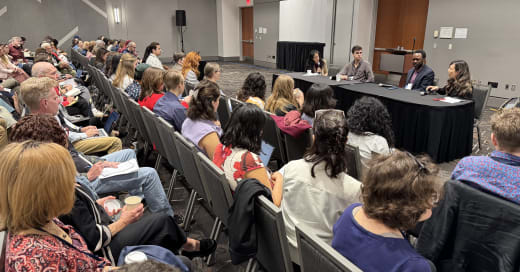I am writing from the National Association of Science Writers conference in Raleigh, North Carolina this weekend. Thank you to freelance journalist Maya L. Kapoor for organizing our panel on “Building Your Story’s Structure,” with speakers John Thomason, features editor at Grist, and Ashley Smart, associate director of the Knight Science Journalism Program at MIT and senior editor at Undark Magazine.
Below, I’ve put together some resources and books we mentioned in our Saturday discussion. I’ve also included seven story structures that can be useful for thinking about longform pieces, as well as links to a few examples of each style. Stories mentioned by our panel are also linked, categorized by structure.
We all agree, there is never just one way to structure a story. Structural choices are subjective. It often comes down to first figuring out what story you are trying to tell and how to best convey it. Structure, at least for me, is one of the hardest parts of writing. It’s always a work in progress, a journey you embark upon with your editors (until it publishes, and you have to let go).
“All narrative is an argument,” one of my mentors told me, “in how we select and order a story.” I return to this advice often when thinking about a nonfiction writer’s role in a story. Whether the narrator is omniscient, a confident guide, or a protagonist, you can find us in the details we choose to include, where we focus our lens, who we choose to interview and quote, how we decide to organize a story’s shape and flow.
I also suggested this resource: “The Narrative Power Edit,” a Google doc written by Sandhya Dirks. It’s an editing resource to check your reporting and think about how power, bias, and privilege are operating in your stories. Dirks points out that stories are always about systems, obvious and less obvious ones that are “always hovering.” Systems, she writes, can also be main characters.
Smart mentioned he learned from the book: “Writing for Story,” by Jon Franklin. “Telling True Stories” is another classic book about narrative journalism craft. And one book that Kapoor and I also appreciate, which is not about nonfiction, but is useful in rethinking structure is “Craft in the Real World,” by Matthew Salesses (Salesses also wrote a braided essay listed below).
The Open Notebook’s Siri Carpenter recently also celebrated the release of the second edition of “The Craft of Science Writing,” an expanded edition.
Seven Story Structures
These are starting points. Frameworks for thinking about story scaffolding, especially for longform science pieces. Some stories blend more than one of these structural approaches.
Object as Character
A main character of a nonfiction story does not have to be person. If you are writing a story focusing on a human subject, you are looking for someone confronting a challenge, tension, pressure, going through a journey, evolving. But an object can also be a main character in a story with high stakes. Similarly, an event or a place can go on a journey, encountering some of the same narrative elements we think of when writing about people.
“The American chestnut tree is coming back. Who is it for?” by Maya Kapoor. Edited by John Thomason for Grist.
“The Launch,” by Brook Jarvis, California Sunday Magazine (main character is a cross-bred apple).
“The Number,” by John Lanchester, The Washington Post (main character is the consumer price index).
“Dark Crystals,” by Tess McClure, The Guardian.
Event or Place as Character
“A Perfect Storm,” by Nick Tabor. Edited by John Thomason for Grist.
“The Indus Republic,” by Alizeh Kohari, Dawn. *Read more about how Kohari finds and thinks about longform story ideas here.
“Inside the Slimy, Smelly, Secretive World of Eel Fishing,” by Paige Williams, The New Yorker.
“27 Days in Tokyo Bay: What Happened on the Diamond Princess,” by Lauren Smiley, Wired.
“Gone,” by Mark Arax, The California Sunday Magazine.
The 9 Structure
This classic story structure begins in the middle of action, en media res (often before the “climax” of the story events). Then it loops back to the beginning, moving forward chronologically, reconnecting to the cliffhanger intro.
“The Alchemists,” by Kim Cross, Bicycling. *My interview with Cross on structuring and interviewing for narrative, and the “9 Structure.”
“Death on Shishapangma,” by Gloria Liu, Outside.
“We Have Fire Everywhere,” by Jon Mooallem, The New York Times Magazine.
“How to Remember a Disaster Without Being Shattered by It,” by Erika Hayasaki, Wired.
“Locked-in Man,” by Lulu Miller, Invisibilia (audio story).
The Layer Cake Structure
This approach is often used in explanatory storytelling. Scene + summary + scene + summary + scene. Profile + context + profile + context + profile. Great transitions are essential.
“Up and Then Down,” by Nick Paumgarten, The New Yorker.
“This grim but revolutionary DNA technology is changing how we respond to mass disasters,” by Erika Hayasaki, MIT Technology Review.
“A celebrated startup promised Kentuckians green jobs. It gave them a ‘grueling hell on earth,’” by Austyn Gaffney. Edited by John Thomason for Grist. (*Layering can also include thinking about alternating between an “A track + B track + C track,” as Thomason, explained).
“Haunting the Human Genome Project: A Question of Consent,” by Ashley Smart, Undark.
The Braided Essay
A braided essay can weave disparate threads, ultimately connecting each juxtaposing strand through the story’s theme.
“The Braided Essay as Social Justice Action,” by Nicole Walker, Creative Nonfiction, who calls this form “radical braiding.” Walker writes: “The tension between two unlike things working against each other does, with enough stress and repetition, press out meaning.”
“To Grieve is to Carry Another Time,” by Matthew Salesses, Longreads.
“Organic Chemistry Taught Me to Fully Inhabit My Mixed Identities,” Ari Remmel, Catapult.
“Emergence,” by Cherise Morris, Scalawag.
“What life is like when your brain can’t recognize faces,” by Sadie Dingfelder, National Geographic.
The Braided Reported Feature
A braided reported piece can involve weaving interlocking threads. Different strands of reporting are connected by the story’s topic and theme. This might include multiple characters. Or a profile + a research storyline. Or a profile of someone else + a first-person story.
“Love in the Time of Robots,” by Alex Mar, Wired.
“Why American’s Black Mothers and Babies Are in a Life-or-Death Crisis,” by Linda Villarosa, The New York Times Magazine.
“To Be a Field of Poppies,” by Lisa Wells, Harper’s.
“In a Perpetual Present,” by Erika Hayasaki, Wired.
“The Social Life of Forests,” by Ferris Jabr, The New York Times Magazine.
“The Butterfly Redemption,” by Brian Payton, Hakai Magazine
“How Motherhood Affects Creativity,” by Erika Hayasaki, The Atlantic.
The Reported Essay
A first-person story grounded in reflection and reporting. These pieces weave facts, scenes, interviews and research with personal observations and narrative storytelling. *Also see “Michelle Nijhuis’s Brief Guide to Writing Reported Essays,” for The Open Notebook.
“The elusive long-billed curlew finds refuge in fragmented grasslands,” by Priyanka Kumar, High Country News.
“A Head Is a Territory of Light,” by Tan Tuck Ming, The Yale Review.
“The Ones We Sent Away,” by Jennifer Senior, The Atlantic.
“The Silent Epidemic of Premature Death in Black Men,” by Nina Harawa. Edited by Ashley Smart for Undark.
The “Bodies” podcast, episode one, “Sex Hurts,” by Allison Behringer, KCRW.
*Coming next week, I will be posting my interview with journalist Lynell George, a master storyteller, especially when it comes to the reported essay.









